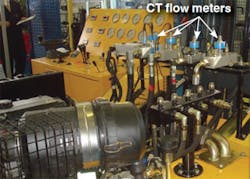In an effort to improve its competitive advantage, a Grand Rapids, Mich. manufacturer decided to automate the production testing process of AC/DC hydraulic power units. With the technical help of distributor Bond Fluidaire, also of Grand Rapids, much of the hand test assembly was automated with clamping and tooling controlled by PLC, complete with data acquisition of the important parameters.
Test parameters included the rotational speed of the motor driving the pump, electrical current draw, fluid pressure, and the output flow rate of the pump. These performance data were matched against engineering specifications, and an automatic pass or fail signal was generated from within the data acquisition software.
Good news and bad news
After implementing the automated test process, managers found that more labor was available for assembly of power packs, so production was ramped up. that was good news. However, a bottleneck developed in the test process. Bad news.
Further investigation revealed that when the electric motor- hydraulic pump was stopped instantaneously at several predetermined points in the test sequence, the analog flow signal from a flow meter took as long as 750 msec to go to zero output. This phantom flow signal caused the system’s PLC to pause — waiting for a zero flow signal — before the next sequence of the tests could be initiated. The result was undue idle time on the test rig.
Getting to the source
The phantom flow signal stemmed from the method employed to detect zero flow. The raw signal from a turbine flow meter is almost universally a low amplitude frequency signal, typically franging from 50 mV to 10 V, with a frequency of 0 to 2000 Hz, depending on size and velocity of the turbine blades.
In today’s electronics, 2000 Hz is relatively slow, and 50 mV amplitude requires specialized circuitry to sense reliably. The frequency signal must be converted to an analog value somewhere in the process for input to PLC or data acquisition inteerface.
Many manufacturers provide the signal conversion either inside the flow meter’s flow transducer or in a converter somewhere between the flow meter and the user interface. For zero signal detection, most manufacturers use the half signal decay method. When no raw frequency signal is detected, the analog signal output is cut by half in every counting cycle until a low limit threshold is reached — a method commonly used to provide averaging of the frequency signal and a smoother output. If the counting cycle is relatively long, reaching the low limit threshold can take a relatively long time.
Bond Fluidaire specified the Webtec CT turbine flow meter because of its fast (50 msec) response time and milliamp output. The difference between 50 msec and 750 msec may not seem like substantial, but with the high throughput of the production line, the result was a 10% to 15% increase in throughput and a happy customer.
This information was provided by Michael G. Thomas, general manager of Webster Instruments USA, Milwaukee. For more information, e-mail him at [email protected] or visit www.webster-inst.com.


